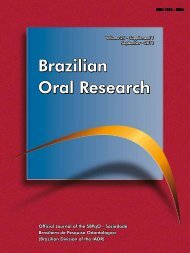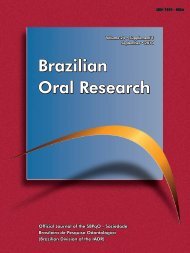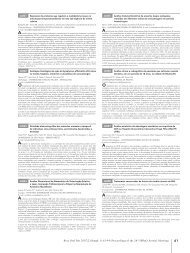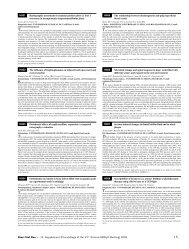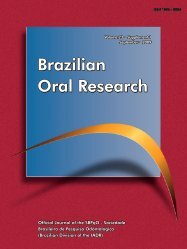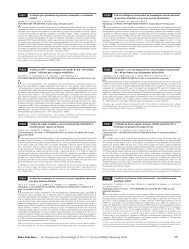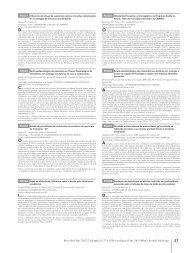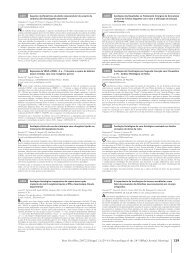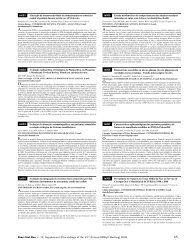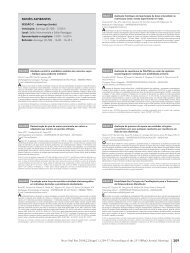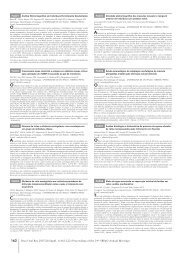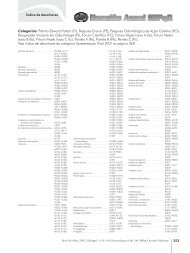Brazilian Oral Research Brazilian Oral Research Brazilian Oral
Brazilian Oral Research Brazilian Oral Research Brazilian Oral
Brazilian Oral Research Brazilian Oral Research Brazilian Oral
Create successful ePaper yourself
Turn your PDF publications into a flip-book with our unique Google optimized e-Paper software.
Association between periodontal diseases and systemic diseases<br />
lar events. However, so far there is limited evidence<br />
regarding this question. Cardiovascular events may<br />
take several years to occur, so the possible benefits<br />
of periodontal therapy are difficult to observe in interventional<br />
studies. Some investigations reported<br />
the effects of periodontal treatment on surrogate<br />
endpoints, such as C-reactive protein, which is associated<br />
with CVD. 12 However, a recent systematic review<br />
concluded that, up to now, there is no evidence<br />
that periodontal treatment can significantly reduce<br />
C-reactive protein levels. 13<br />
Few studies regarding this association have been<br />
conducted in the <strong>Brazilian</strong> population. One case-<br />
control study and two cross-sectional studies were retrieved<br />
from the Medline and Scielo databases, using<br />
the words “periodontitis”, “periodontal”, “cardiovascular”,<br />
“infarction” and “atherosclerosis” (Table 1).<br />
The case control study, conducted in Southern<br />
Brazil, found a significant association between<br />
periodontitis and acute coronary syndrome. 16 One<br />
cross-sectional study 14 observed significant association<br />
between periodontal disease and severe obstruction<br />
of coronary artery. However, the authors<br />
did not present multivariate analysis with adjustment<br />
for confounders related to periodontitis and<br />
CVD. The other cross-sectional study 15 did not<br />
present a multivariate analysis to investigate the association<br />
between the two conditions, and reported<br />
that periodontal disease was elevated in patients<br />
4 Braz <strong>Oral</strong> Res 2008;22(Spec Iss 1):32-43<br />
with Ischemic Coronary Atherosclerosis. Some potential<br />
methodological biases should be considered<br />
in order to avoid erroneous conclusions about a<br />
causal relationship between periodontal disease and<br />
adverse cardiovascular events in these populations.<br />
The criteria adopted to define periodontal disease<br />
exposure in these studies must also be carefully<br />
analyzed. More interventional studies, with larger<br />
sample sizes, need to be conducted in the <strong>Brazilian</strong><br />
population.<br />
Adverse pregnancy outcomes and<br />
periodontal diseases<br />
This section will focus particularly on the relationship<br />
between periodontal diseases and preterm<br />
birth and low birth weight, which has been extensively<br />
studied in last years all over the world.<br />
The first study to report the influence of poor<br />
oral health on the birth of low weight and preterm<br />
infants was performed by Offenbacher and colleagues.<br />
17 They obtained obstetric and demographic<br />
information from the studied patients’ prenatal records<br />
and performed full mouth periodontal examinations<br />
in 93 mothers who gave birth to preterm<br />
or low weight infants and compared them to those<br />
of 31 mothers who had term deliveries and normal<br />
weight infants. Multivariate analysis showed that<br />
the women with more than 60% of sites with clinical<br />
attachment loss of 3 mm or more were seven<br />
Table 1 - Studies assessing the relationship between periodontal disease and cardiovascular diseases in <strong>Brazilian</strong> populations.<br />
Authors Study design Population<br />
Accarini,<br />
de Godoy 14<br />
(2006)<br />
Barilli et al. 15<br />
(2006)<br />
Rech et al. 16<br />
(2007)<br />
Cross-<br />
Sectional<br />
Cross-<br />
Sectional<br />
361 patients from a<br />
Hospital in São Paulo (SP)<br />
634 patients from a<br />
Hospital in Ribeirão Preto<br />
(SP)<br />
Case-control 58 cases (acute coronary<br />
syndrome) and 57<br />
matched controls from a<br />
hospital in Gravataí (RS)<br />
Periodontal outcome or<br />
exposure<br />
30% of sites with clinical<br />
attachment level and/or<br />
periodontal pocket<br />
depth ≥ 5 mm<br />
Presence of periodontal<br />
disease according to<br />
Community Periodontal<br />
Index<br />
Presence of periodontal<br />
pockets, attachment loss<br />
and gingival inflammation<br />
Cardiovascular<br />
disease outcome<br />
Severe obstruction<br />
of coronary artery<br />
(at least one<br />
obstruction ≥ 50%)<br />
Ischemic Coronary<br />
Atherosclerosis<br />
Presence of acute<br />
coronary syndrome<br />
Findings and conclusions<br />
Significant association<br />
between periodontal<br />
disease and severe<br />
obstruction of coronary<br />
artery (OR 2.571, CI<br />
1.192-5.547)<br />
Periodontal disease<br />
was elevated in patients<br />
with Ischemic Coronary<br />
Atherosclerosis<br />
Significant association<br />
between periodontitis and<br />
acute coronary syndrome<br />
(OR 5.1 CI 1.7-14.8)



